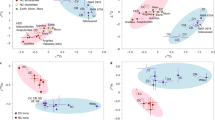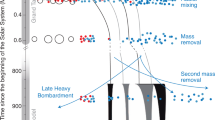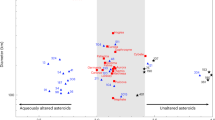Abstract
Asteroid collisions in the main belt eject fragments that may eventually land on Earth as meteorites1,2,3. It has therefore been a long-standing puzzle in planetary science that laboratory spectra of the most populous class of meteorite (ordinary chondrites, OC) do not match the remotely observed surface spectra of their presumed (S-complex) asteroidal parent bodies. One of the proposed solutions to this perplexing observation is that ‘space weathering’ modifies the exposed planetary surfaces over time through a variety of processes (such as solar and cosmic ray bombardment, micro-meteorite bombardment, and so on). Space weathering has been observed on lunar samples4, in Earth-based laboratory experiments5,6, and there is good evidence from spacecraft data that the process is active on asteroid surfaces7,8. Here, we present a measurement of the rate of space weathering on S-complex main-belt asteroids using a relationship between the ages of asteroid families and their colours9. Extrapolating this age–colour relationship to very young ages yields a good match to the colour of freshly cut OC meteorite samples, lending strong support to a genetic relationship between them and the S-complex asteroids.
This is a preview of subscription content, access via your institution
Access options
Subscribe to this journal
Receive 51 print issues and online access
$199.00 per year
only $3.90 per issue
Buy this article
- Purchase on Springer Link
- Instant access to full article PDF
Prices may be subject to local taxes which are calculated during checkout


Similar content being viewed by others
References
Vokrouhlický, D. & Farinella, P. Efficient delivery of meteorites to the Earth from a wide range of asteroid parent bodies. Nature 407, 606–608 (2000)
Gladman, B. J. et al. Dynamical lifetimes of objects injected into asteroid belt resonances. Science 277, 197–201 (1997)
Wisdom, J. Meteorites may follow a chaotic route to earth. Nature 315, 731–733 (1985)
Adams, J. B. & McCord, T. B. Alteration of lunar optical properties: Age and composition effects. Science 171, 567–571 (1971)
Moroz, L. V., Fisenko, A. V., Semjonova, L. F., Pieters, C. M. & Korotaeva, N. N. Optical effects of regolith processes on S-asteroids as simulated by laser shots on ordinary chondrite and other mafic materials. Icarus 122, 366–382 (1996)
Sasaki, S., Nakamura, K., Hamabe, Y., Kurahashi, E. & Hiroi, T. Production of iron nanoparticles by laser irradiation in a simulation of lunar-like space weathering. Nature 410, 555–557 (2001)
Chapman, C. R. S-type asteroids, ordinary chondrites, and space weathering: The evidence from Galileo's fly-bys of Gaspra and Ida. Meteorit. Planet. Sci. 31, 699–725 (1996)
Clark, B. E. et al. Space weathering on Eros: Constraints from albedo and spectral measurements of Psyche crater. Meteorit. Planet. Sci. 36, 1617–1637 (2001)
Ivezić, Ž., Jurić, M., Lupton, R. H., Tabachnik, S. & Quinn, T. in Survey and Other Telescope Technologies and Discoveries (eds Tyson, J. A. & Wolff, S.) Vol. 4836, 98–103 Proc. SPIE (2002)
Hapke, B. Space weathering from Mercury to the asteroid belt. J. Geophys. Res. 106, 10039–10074 (2001)
Michel, P., Benz, W., Tanga, P. & Richardson, D. C. Collisions and gravitational reaccumulation: Forming asteroid families and satellites. Science 294, 1696–1700 (2001)
Milani, A. & Knežević, Z. Asteroid proper elements and the dynamical structure of the asteroid main belt. Icarus 107, 219–254 (1994)
Gaffey, M. J. et al. Mineralogical variations within the S-type asteroid class. Icarus 106, 573–602 (1993)
Doressoundiram, A., Barucci, M. A., Fulchignoni, M. & Florczak, M. EOS family: A spectroscopic study. Icarus 131, 15–31 (1998)
Deeming, T. J. Stellar spectral classification, I. Mon. Not. R. Astron. Soc. 127, 493–516 (1964)
Ivezić, Ž. et al. Color confirmation of asteroid families. Astron. J. 124, 2943–2948 (2002)
Tedesco, E. F., Noah, P. V., Noah, M. & Price, S. D. The supplemental IRAS minor planet survey. Astron. J. 123, 1056–1085 (2002)
Sykes, M. V. et al. The 2MASS asteroid and comet survey. Icarus 146, 161–175 (2000)
Bus, S. J. & Binzel, R. P. Phase II of the small main-belt asteroid spectroscopic survey. Icarus 158, 106–145 (2002)
Migliorini, F. et al. Surface properties of (6) Hebe: A possible parent body of ordinary chondrites. Icarus 128, 104–113 (1997)
Morbidelli, A. & Vokrouhlický, D. The Yarkovsky-driven origin of near-Earth asteroids. Icarus 163, 120–134 (2003)
Marti, K. & Graf, T. Cosmic-ray exposure history of ordinary chondrites. Annu. Rev. Earth Planet. Sci. 20, 221–243 (1992)
Binzel, R. P., Bus, S. J., Burbine, T. H. & Sunshine, J. M. Spectral properties of near-Earth asteroids: evidence for sources of ordinary chondrite meteorites. Science 273, 946–948 (1996)
Rabinowitz, D. L. Size and orbit dependent trends in the reflectance colours of earth-approaching asteroids. Icarus 134, 342–346 (1998)
di Martino, M., Manara, A. & Migliorini, F. 1993 VW: an ordinary chondrite-like near-Earth asteroid. Astron. Astrophys. 302, 609–612 (1995)
Lazzarin, M., di Martino, M., Barucci, M. A., Doressoundiram, A. & Florczak, M. Compositional properties of near-Earth asteroids: spectroscopic comparison with ordinary chondrite meteorites. Astron. Astrophys. 327, 388–391 (1997)
Gaffey, M. J. Spectral reflectance characteristics of the meteorite classes. J. Geophys. Res. 81, 905–920 (1976)
Acknowledgements
We thank C. Chapman and J. Taylor for providing background on the S-complex conundrum and B. Clark for useful discussions and further studies. D.N. thanks NASA PG&G and the SwRI Quicklook programmes for providing support. Funding for the creation and distribution of the SDSS Archive has been provided by the Alfred P. Sloan Foundation, the Participating Institutions, the National Aeronautics and Space Administration, the National Science Foundation, the US Department of Energy, the Japanese Monbukagakusho, and the Max Planck Society. The SDSS website is http://www.sdss.org/.
Author information
Authors and Affiliations
Corresponding author
Ethics declarations
Competing interests
The authors declare that they have no competing financial interests.
Supplementary information
Supplementary Information
Contains Supplementary Table 1 giving the ages and colours of S-complex asteroids as well as two methods sections summarizing the techniques used for asteroid family identification and age determination. (DOC 60 kb)
Rights and permissions
About this article
Cite this article
Jedicke, R., Nesvorný, D., Whiteley, R. et al. An age–colour relationship for main-belt S-complex asteroids. Nature 429, 275–277 (2004). https://doi.org/10.1038/nature02578
Received:
Accepted:
Issue Date:
DOI: https://doi.org/10.1038/nature02578
This article is cited by
-
Asteroid families: properties, recent advances, and future opportunities
Celestial Mechanics and Dynamical Astronomy (2022)
-
Solar wind as the origin of rapid reddening of asteroid surfaces
Nature (2009)
-
A perfect match?
Nature (2004)
Comments
By submitting a comment you agree to abide by our Terms and Community Guidelines. If you find something abusive or that does not comply with our terms or guidelines please flag it as inappropriate.



